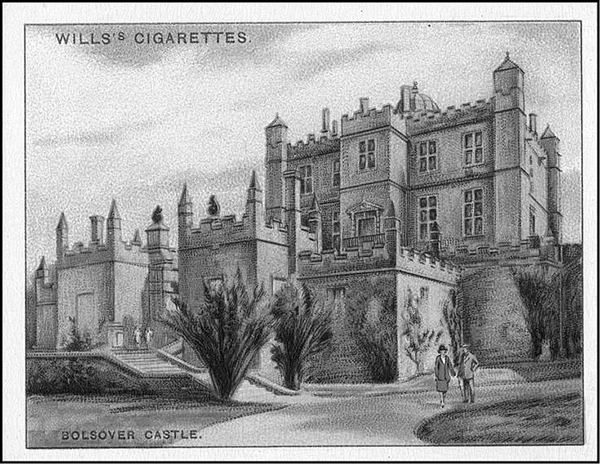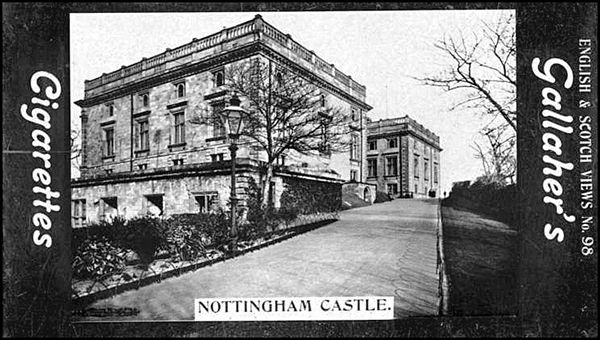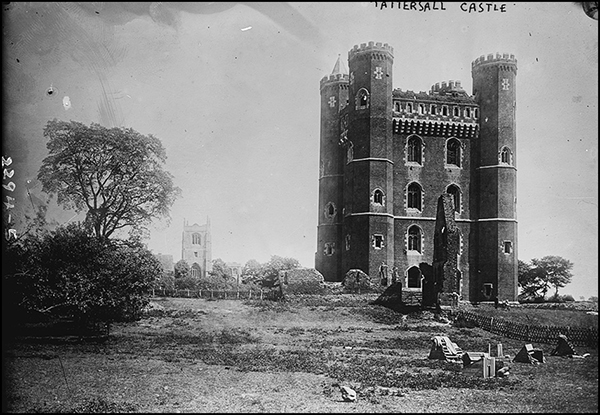Five

Northamptonshire
www.castleuk.net/castle_lists_midlands
/141/barnwellcastle.htm
Built in 1266 during the reign of King Henry III by the powerful Berengar Le Moine family, the castle has huge thick walls some ten metres high and is situated south of the town, west of the village of Barnwell, in Northamptonshire. It is a Grade I building and a Scheduled Ancient Monument and sits on the site of a previous motte-and-bailey castle.
During the English Civil War it was used as an arsenal for the Royalists by its owner Sir Edward Montagu. Although in ruins, substantial parts of the castle remain and it is privately owned. Local legend suggests that the body of Berengar’s brother, Wintner, is bricked up somewhere within its imposing walls.
The castle is supposedly haunted by the spectre of a woman prisoner by the name of Marie Le Maine who is said to have been bricked up alive soon after the castle was built. Her ghost has been witnessed by a postman, passing pedestrians and even a policeman who happened to be patrolling by the castle. As well, strong gusts of wind felt on windless days are attributed to the ghost of a murdered monk who is rumored to walk the grounds wielding a whip.
Derbyshire
www.english-heritage.org.uk/visit/places/bolsover-castle

Built in the early seventeenth century by the Cavendish family on the site of a medieval castle founded in the twelfth century by the Peverel family, Bolsover Castle is a Grade I building. By the 1770s the castle was in a ruinous state and the estate passed to the Dukes of Portland, who kept the castle as a retreat until the early nineteenth century. For most of the nineteenth century it was tenanted and used as a vicarage. In 1946 it was passed over to the Ministry of Works, who stabilized and restored the buildings.
It is reportedly one of the most haunted sites in the region with staff and visitors alike having reported being pushed, seeing apparitions and items being moved as if by invisible hands. Some security guards have resigned after being spooked by seeing lights moving in parts of the property that were empty and hearing unexplained noises while on duty at night. On one occasion, it was reported that four builders working in the garden reported seeing a woman in a bustle-style dress who appeared and then subsequently disappeared though a wall. Two of the group declined to return the following day.
Diane Hinchcliffe, the site supervisor stated that; “Pretty much all the staff have had some experiences,” although she noted that; “I am not necessarily a believer in ghosts. I think there is a rational explanation for everything, but there have been events that I cannot explain.”
Display figures have moved around the site at night, whilst items left in a locked storeroom, including visitor’s belongings, have also been moved although Hinchcliffe suggests that there is “the possibility of pranks and send ups.” However, she also suggested that “there have been times when I have been the last to leave at night and the first to arrive in the morning and things have been changed. I have had things moved in locked rooms.”
Visitors regularly report seeing ghostly figures. One of the most commonly sighted is said to be an apparition of a child, which is said to be seen holding the hands of young visitors. Ghostly figures have also been reported in the chamber under the castle, including a man wearing a ruff and a woman in a scarf who have been spotted standing together before vanishing. A ghostly woman has also been seen in the kitchen area ominously placing a small child into the fireplace before vanishing.
Why she is placing a child into the fireplace is unknown but the very thought of it conjures up horrific images.
Lincolnshire
www.lincolncastle.com
One of the most impressive Norman castles in the United Kingdom and built in 1068 on the site of a pre-existing Roman fortress, Lincoln Castle was one of the first motte-and-bailey castles to be constructed in England by William the Conqueror. The castle is unusual in that it has two mottes making it only one of two such castles in the country, the other example of this construction being at Lewes in Sussex.
On one of these mottes stands a fourteenth-century observatory tower whilst a twelfth-century shell keep, called Lucy Tower, sits atop the other. The castle also boasts two gates, a large round tower, and a cobb hall. Later additions included a prison, which has since been closed, and a Victorian courthouse which is still in use today. The castle also houses one of only four surviving copies of the Magna Carta. And with such an illustrious past, it is no wonder it is believed to be haunted.
Executions took place at the castle after it became a prison and this could help explain the amount of supernatural activity that is regularly reported throughout the castle, including frequent sightings of a lady carrying a baby who is seen walking down the stairs of the Old Victorian Women’s Prison and unexplained lights inside the chapel where the doors have a habit of opening and closing by themselves. At the male prison, doors have been reported to slam shut and visitors have been shocked by the sound of keys jangling, footsteps and disembodied moans and screams.
Cobb Hall also has its ghostly apparitions with reports of a lady dressed in black who walks up and down the stairs leading to the old gallows, while the Observatory Tower is plagued by strange shadows and dark shapes descending the stairs. As well, visitors often report strange growls and crying in the prisoner’s graveyard. A malnourished hound, once owned by a criminal who was hanged at the castle, spent the rest of its life waiting for its dead master and is now occasionally spotted around the castle walls still waiting.
In April 2004 Richard Hart and his partner Angela Allen got the fright of their lives when they took their two children up the observatory tower’s stone stairs. Climbing the stairs they both experienced a chilling feeling. Hart used his digital camera to take some photographs and later, when he downloaded the pictures he found a ghostly image on one of the shots.
Hart noted that “All of a sudden, my partner started feeling really edgy and said she couldn’t go up any further. I followed the children and although it was quite a warm day, I started to feel cold. When we went back down, there were some people looking after Angela and thinking she had suffered a funny turn. Angela is into the whole spiritual thing and we have heard before that she could be psychic so we wonder if she sensed something.”
He also noted that none of the photos taken before or after showed the ghostly figure. “There really is no explaining it at all. It was really scary I have to say. I won’t be going there again in a hurry.”
Margaret Green, who runs the Lincoln Ghost Walk, stated that it was not the first time she had heard of strange happenings in the observatory tower. “About six or seven years ago a couple told me they were heading up the stairs and they saw a couple walking in front of them. When they reached the top, the couple had vanished and there was nowhere they could have gone. Last year, a young woman said that as she was walking up the steps, she started experiencing unbearable pain and had to be helped by other visitors. On the way back down the pain got less and less until it vanished. She asked me if anyone had ever been murdered there because she felt as though that was what was happening to her. It is possible that there is something ghostly there.”
Nottinghamshire
www.newark-sherwooddc.gov.uk/newarkcastle
Newark Castle, in Nottinghamshire, was originally a timber castle but was rebuilt in stone in the mid-twelfth century by Alexander, Bishop of Lincoln. In 1648 it was slighted after the English Civil War but was later restored by architect Anthony Salvin between 1845 and 1848. Further restoration works were carried out in 1889 and today it is a Scheduled Ancient Monument and a Grade I building as well as being recognized as an internationally important structure.
Interestingly, King John, the youngest of five sons of King Henry II and Eleanor of Aquitaine, died from dysentery after a feast at the castle in October 1216. On the night of his death a thunderstorm swept over the area and was later described in its ferocity as “the Devil himself coming to claim King John’s soul”.
It has been suggested that, in the early 1900s a castle ranger was found hanged in the King’s Bedroom and tour guides have since reported seeing his ghost hanging from the ceiling, twitching and jolting as if struggling for breath. In the dungeon, voices and chanting have been heard while in the oubliette, a terrifying and oppressive place, visitors have reported a sense of unease as if they are being watched.
Strange unexplained flashes of light have been spotted in the castle grounds, as well as screaming and shouting being heard from the curtain wall which borders the river. Visitors in the castle grounds have also experienced cold spots and the undercroft is said to have a presence that sends cold shivers down your spine.
Peter Cox, who visited Newark Castle as a boy on a school trip, reported that he had a supernatural encounter one cold day in October when he went on a guided tour of the castle while on a school excursion. He explained that, in those days they got to see a lot more of the castle and had the opportunity of climbing down a ladder into the dungeon. He recalled that the temperature dropped rapidly and that the group was down there for at least ten minutes when he noticed something strange. “I could hear voices, not from the tour guide, they were hushed and almost muted. They grew louder and louder, and I remember asking my mate if he could hear anything. He said I was mad, but I’m sure that I could see someone in the corner, standing in the shadows watching us. I did no more and got back up the ladder to the opening as fast as I could.”
And more recently, in 2015, Mr Lenny Low claimed to have taken a photograph showing the ghost of a fisherwoman while visiting the castle one overcast afternoon.
“When looking at the photos, one has a strange dark blemish in the right hand corner. Zoom in and this character appears, walking into what would be the pantry storeroom of the castle. It looks like how the fisherwomen of old dressed. The doorway it’s walking into is fenced off but was the storeroom of the castle, the kitchen is next door on the left. It looks like a woman with her sleeves rolled up in a busy like manner. Being 100 yards from the sea it’s more likely to be a fisherman’s wife—one who spent her time gutting and salting the fish.”
Nottinghamshire
www.nottinghamcastle.org.uk

Located on a natural outcrop known as Castle Rock, with cliffs 40 metres high to the south and west, Nottingham Castle holds a commanding position over the city. First constructed as a Norman motte-and-bailey in 1067, it was extensively rebuilt in stone by King Henry II from 1150. In 1194 it was being sieged by Richard the Lionheart as part of the campaign to put down the rebellion of Prince John. The Castle surrendered after just a few days.
In 1642 at the start of the Civil War, Charles I chose Nottingham as the rallying point for his armies, but soon after he departed, the castle was held by the Parliamentarians who repulsed several Royalist attacks. Then, in 1651, on the orders of John Hutchinson, the remnants of the castle were demolished. The Duke of Newcastle later built a mansion on the site; however, this was burnt down by rioters in 1831. The mansion was later rebuilt to house an art gallery and museum and these remain today, although very little of the original castle survives.
Nottingham Castle is said to be haunted by a number of different ghosts, with the main one being that of Roger Mortimer the Earl of March and lover of Queen Isobel, and who was probably her accomplice in the murder of Edward II. Sir Roger was imprisoned in the castle and later taken to London where he was hanged, drawn and quartered in November 1330. Under the castle, carved into the sandstone outcrop on which the castle stands, is a cave known as Mortimer’s Hole where Sir Roger Mortimer’s ghost makes its presence known on occasions. His ghost is also heard pacing about his former cell as if unaware that he has been dead for centuries.
Equally, Queen Isabella’s spirit is said to haunt the interior of the castle, screaming for her lost love while an unknown phantom child also lurks within the walls, appearing to shock visitors on occasions. Although it is unknown, it is possible that this ghostly child is one of the 28 sons of Welsh nobility that King John took hostage in 1212. The boys, some as young as 12, lived at the castle for some time, but were treated well and were allowed free rein within the walls. However, one day this all changed when John had them all executed in cold blood, taken up to the ramparts and hanged. It is said that the boy’s pitiful cries for mercy still ring out around the castle.
Derbyshire
www.english-heritage.org.uk/visit/places/peveril-castle

Peveril Castle is a Scheduled Monument and a Grade I listed building overlooking the village of Castleton in the English county of Derbyshire. Also known as Castleton Castle or Peak Castle, it was built in the eleventh century as the main settlement of the feudal barony of William Peveril. It is mentioned in the Domesday Survey of 1086.
William Peveril the Younger later inherited the castle, however, in 1155 it, as well as the Peveril estate, was confiscated by King Henry II. In 1199 William de Ferrers acquired the castle although it remained under royal control. The closest Peveril Castle came to seeing actual warfare was in 1216.
In 1223 the castle was returned to the Crown and by the end of the fourteenth century, the barony was granted to John of Gaunt, Duke of Lancaster. Having little use for the castle, he ordered its material to be stripped for re-use and the castle began to fall into disrepair. By 1609 it was a ruin and abandoned.
The ghost of a knight has been observed standing by the keep while his riderless horse trots around nearby, and strange banging and clanking has been reported after dark, with searches revealing no apparent source. As well, the ghost of an old lady and a phantom horse have been reported in the area.
Lincolnshire
www.nationaltrust.org.uk/tattershall-castle

Originally a stone castle or a fortified manor house, built by Robert de Tattershall in 1231, Tattershall Castle was largely rebuilt in brick and expanded by Ralph, 3rd Lord Cromwell, between 1430 and 1450. Today it remains one of the three most important surviving brick castles of the mid-fifteenth century as brick castles were far less common in England than stone or earth and timber constructions as brick was chosen more often than not for its aesthetic qualities over defensive. About 700,000 bricks were used to build the castle, which has been described as the finest piece of medieval brick work in England.
Cromwell died in 1456 with the castle inherited by his niece, Joan Bouchier. However, it was soon confiscated by the Crown only to be recovered in 1560 by Sir Henry Sidney, who later sold it to Lord Clinton, later the Earl of Lincoln, where it remained until 1693. After this it was passed to the Fortesques before falling into disrepair. Today it is managed by English Heritage and is open to the public.
Although seemingly quiet with regards to the supernatural, the castle is nevertheless said to be haunted by the ghost of a White Lady who walks the lonely battlements at night. Who she is, no one knows.
Although I have not visited Tattershall castle since I was a young boy in the 1970s, I still remember the feelings of awe, wonderment and, somewhat, apprehension. From its majestic red turrets one could watch F4 Phantom jets as they landed and took off at a nearby RAF base, which was truly exciting as a young boy. And yet, it is that feeling of something else that remains with me to this day. That indescribable feeling that I was not alone in this place …